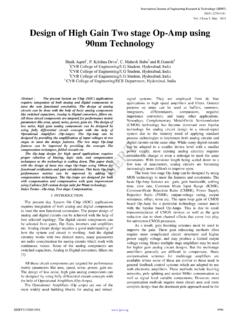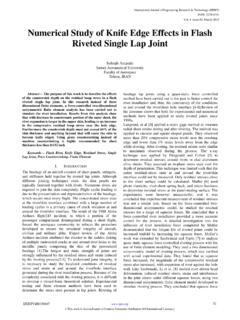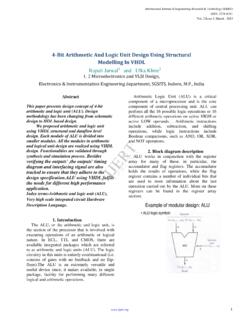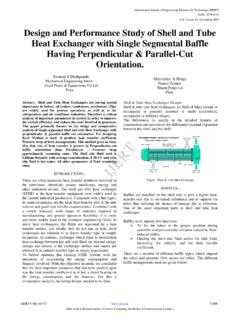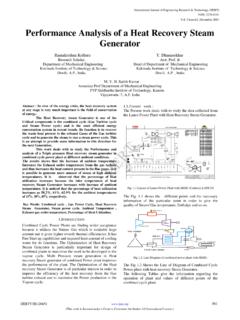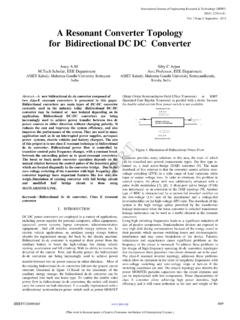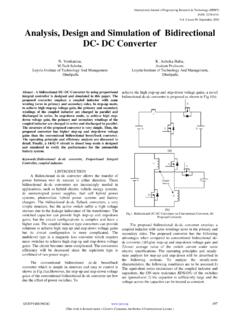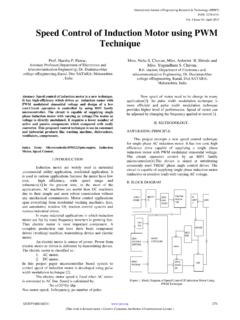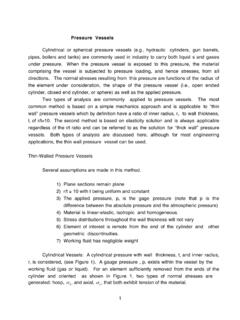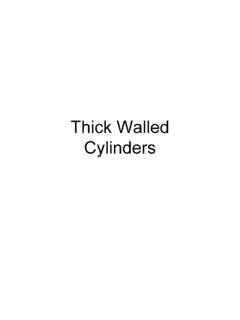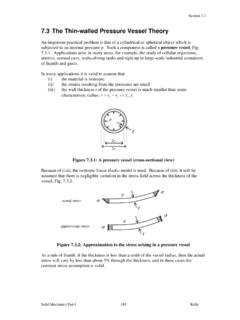Transcription of Buckling Analysis of Thin Walled Cylinders Subjected to ...
1 Buckling Analysis of thin Walled Cylinders Subjected to Axially Compressive Load by ANSYS K. N. Kadam1 Assistant Professor, Department of Applied Mechanics, Govt college of Engineering, Amravati. Nazim S. Khan2 Student, Department of Applied Mechanics, Govt college of Engineering, Amravati. Abstract Buckling is a critical phenomenon in structural failure under compression load. Buckling strength of structures depends on many parameters like supports, linear material, composite or nonlinear material etc. Buckling behavior is also influenced by thermal loads and imperfections.
2 Analyzing all these conditions is difficult task. So few parameters are considered for the present work. Due to the advances in the Finite element techniques, Analysis of these problems is possible which is difficult in earlier days. In the present work thin - Walled Cylinders are considered for Buckling Analysis . Shell63 element from ANSYS software in elastic range is used . Keywords:- Critical Buckling , Linear Buckling , Eigen value, thin shells Buckling , ANSYS. 1. Introduction When a structure undergoes visibly large displacements transverse to the load then it is said to buckle.
3 Buckling may be demonstrated by pressing the opposite edges of a flat sheet of cardboard towards one another. Local Buckling of cylindrical shells is indicated by the growth of bulges, waves or ripples, and is commonly encountered in the component plates of thin structural members. If Buckling deflections become too large then the structure fails this is a geometric consideration, completely separated from any material strength consideration. If a component or part therefor is prone to Buckling then its design must satisfy both strength and Buckling safety constraints that is why Buckling is important.
4 thin - Walled Cylinders of various constructions find wide uses as primary structural elements in simple and complex structural configurations. The round cylinder is popular in column design, in tubing and piping, and in offshore platforms. Stiffened and unstiffened metallic and laminated composite thin (large diameter to thickness ratios) shells are used extensively in underwater, surface, air, and space vehicles as well as in the construction of pressure vessels, storage bins, and liquid storage tanks. thin - Walled cylindrical tanks are prone to Buckling collapse due to accidentally induced internal vacuum.
5 While internal under-pressures can be generated for a variety of reasons, the condensation of steam in the vessel results in a particularly rapid and severe level of vacuum loading. The particular motivation for this research is tank collapse or pressure vessel failure in the food, pharmaceutical and biotechnology industries. These vessels are routinely filled with saturated steam as part of cleaning, sterilization or purging cycles. Condensation of the steam if accompanied by inadvertent closure of all vessel valves will lead to a rapid drop in internal pressure and vessel failure.
6 Such a collapse, if it occurs, tends to be catastrophic resulting in the complete destruction of the vessel . Two hypotheses regarding the type of material modeling are used, linear Buckling Analysis and nonlinear Buckling Analysis . 1407 International Journal of Engineering Research & Technology (IJERT)Vol. 2 Issue 12, December - 2013 ISSN: Analytical solution A thin - Walled Cylinders simply supported at the ends is uniformly compressed in the axial direction as shown in Fig. 1. Figure 1: thin - Walled Cylinders Subjected to axial load Using equation of stress can be compared with theoretical results =Nxt=R E 1 2 (1) where R= 1 2 4+ 2+ 2 4 2+ 3 4 2+2 4 1 2 2 4 7+ + 2n2 3+ + 4 2 6 (2) S= 2 2+ 2 2+21 2+1 2 2 1+ 2+ 2 2 2 2 21 +2 1 2+1 2 2 2+ 1 2 (3)
7 =t212R2 (4) =mR H (5) The simplified forms of is cr =Nxt=1 2E n2+ 2 2 2+ 1 2 2 n2+ 2 2 (6) When the value of n in is equal to zero, axisymmetric Buckling occurs, and is simplified as cr =N =D m2 2tH2+EH2R2Dm2 2 (7) The stress equation as follows =EtR 3 1 2 (8) 3.
8 Numerical Analysis The structural static Analysis capabilities in the ANSYS program are used to determine the displacements, stresses, strains, and forces that occur in a structure or component as a result of applied loads. Static Analysis is appropriate for solving problems in which the time-dependent effects of inertia and damping do not significantly affect the structure s response. Static Analysis in the ANSYS program can also include nonlinearities such as plasticity, creep, large deflection, large strain, and contact surfaces. A nonlinear static Analysis is usually performed by applying the load gradually so that an accurate solution can be obtained.
9 A: Element Type This Analysis considers the shell 63 element which has both bending and membrane capabilities. Both in-plane and normal loads are permitted. The element has six degrees of freedom at each node: translations in the nodal x, y, and z directions and rotations about the nodal x, y, and z-axes. Stress stiffening and large deflection capabilities are included. A consistent tangent stiffness matrix option is available 1408 International Journal of Engineering Research & Technology (IJERT)Vol. 2 Issue 12, December - 2013 ISSN: use in large deflection (finite rotation) analyses.
10 Fig. 2. shows the details of shell 63 element. Figure 2: Shows The details of shell 63 element B: Boundary conditions and modeling of cylinder For each of the two ends, two different types of boundary conditions (Fig 3) are used. At the fixed end, displacement degrees of freedom in 1, 2, 3 directions (U1, U2 , U3) as well as rotational degrees of freedom in 1, 2, 3 directions ( 1, 2, 3) were restrained to be zero. At the movable end, load was exerted with an even stress distribution in the longitudinal direction U1. Figure 3: Modeling of cylinder 4. Mathematical Modeling Buckling Analysis is used to determine: 1) The load level at which a structure becomes unstable.

